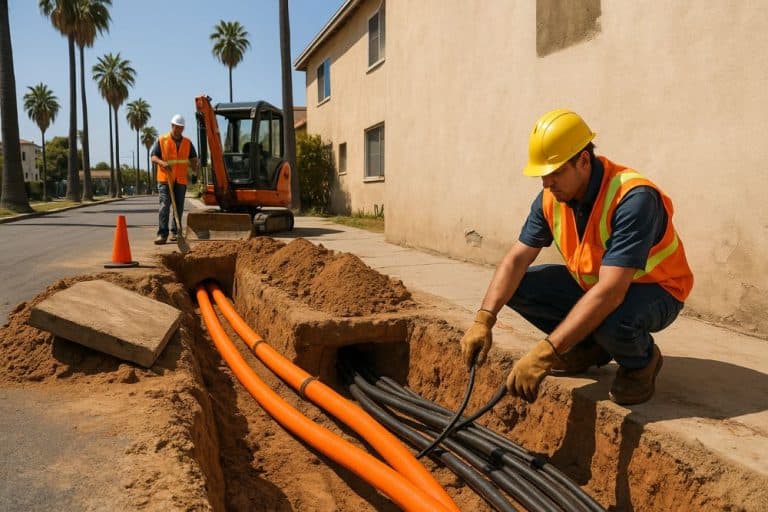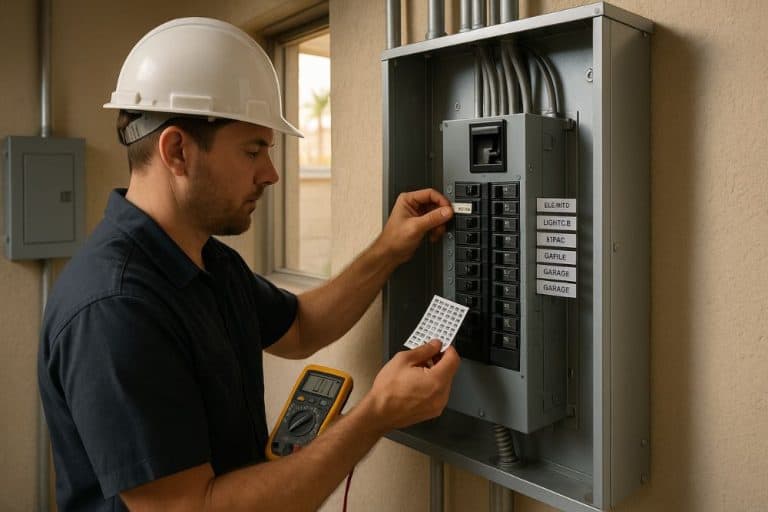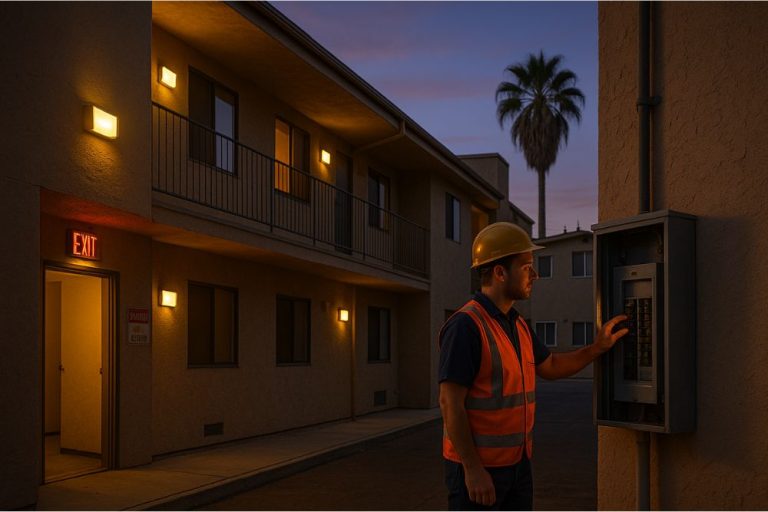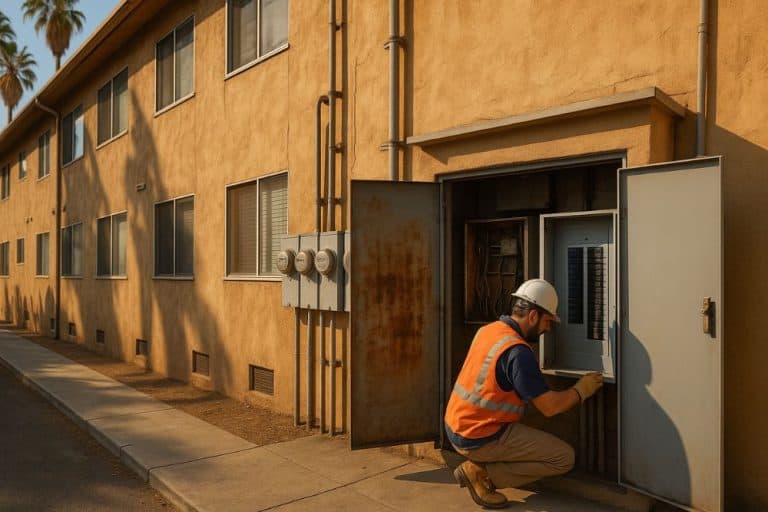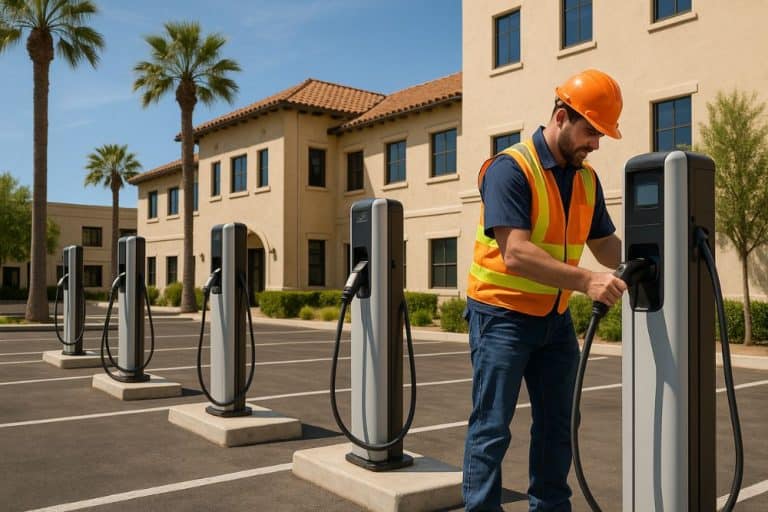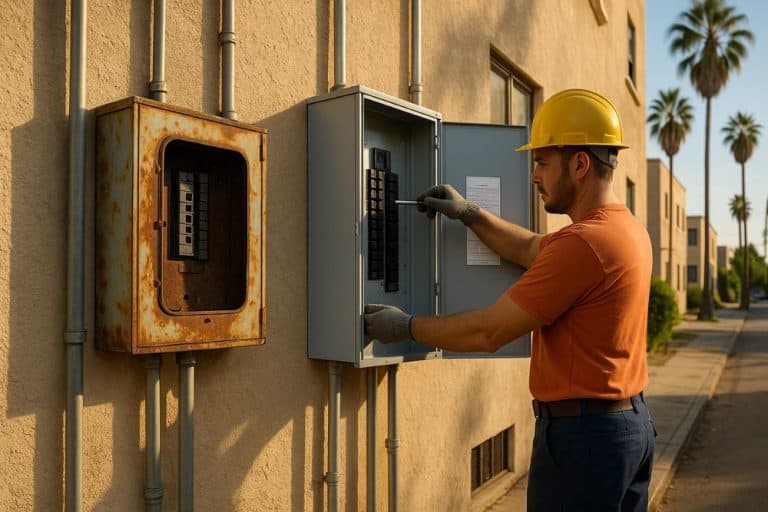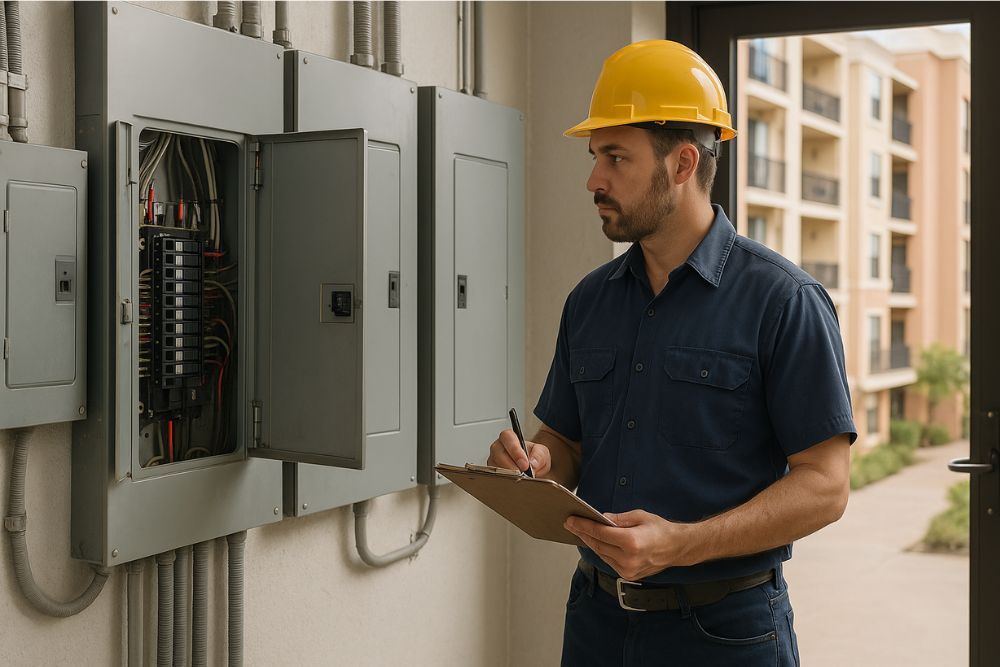
Top Electrical Code Violations in LA Apartment Buildings
Why Code Compliance Matters for LA Property Managers
If you manage apartment complexes in Los Angeles, you already juggle more responsibilities than most people realize. Between tenant requests, maintenance emergencies, budgeting, and city inspections, your to-do list never ends. Electrical code compliance may not always make it to the top of that list — but when it slips through the cracks, the consequences can be severe.
The High Stakes of Electrical Code Compliance in LA
Los Angeles is a city with some of the strictest building codes in the country, and for good reason. Multi-unit properties house hundreds of thousands of residents, and outdated or unsafe electrical systems can put every single one of them at risk. A missed GFCI outlet in a bathroom, an old Zinsco panel in a utility closet, or wiring splices hidden behind drywall might not seem urgent, until they cause a fire, an injury, or a failed inspection.
The city takes these risks seriously. Code enforcement officers conduct inspections, and the Rent Escrow Account Program (REAP) can strip landlords of rental income if violations aren’t corrected quickly. That means one overlooked breaker panel or improperly grounded circuit can ripple into months of lost revenue.
👉 Related: Electrical Code Compliance in Los Angeles
Your Tenants Are Counting on You
From a StoryBrand perspective, your tenants are the heroes of their own stories. They want safe, reliable homes where they don’t have to worry about flickering lights, tripping breakers, or worse — electrical fires. As a property manager, you’re their guide, making sure the environment is safe and livable. But here’s the truth: without code-compliant electrical systems, even the best-managed building becomes a liability.
Consider this scenario: a tenant plugs in a space heater during a cold LA night, and the breaker doesn’t trip because the panel is decades old and never upgraded. The outlet overheats, sparks, and suddenly you’re dealing with an electrical fire. Tenants are displaced, insurance is involved, and your property’s reputation takes a hit. All because of a code issue that could have been prevented.
Insurance and Liability Risks
Insurance companies in Los Angeles are becoming increasingly strict. Many now require proof that electrical systems meet current code before issuing or renewing policies. If an electrical fire occurs and the investigation reveals violations, such as missing GFCIs, aluminum wiring, or outdated panels — coverage may be denied. That leaves property owners and managers holding the bag for repairs, legal claims, and tenant losses.
From a financial standpoint, staying code-compliant isn’t just about avoiding fines. It’s about protecting your investment. Deferred compliance may seem like a way to save money, but in reality, it creates massive financial exposure.
👉 Related: Commercial Electrical Services in Los Angeles
The Cost of Non-Compliance vs. The Cost of Prevention
Here’s the part most property managers miss: the cost of preventive electrical work is almost always less than the cost of dealing with violations. Installing GFCIs, upgrading a panel, or labeling breakers might seem like expenses today, but they’re tiny compared to:
- A five-figure fire damage bill.
- Monthly revenue loss under REAP.
- Skyrocketing insurance premiums.
- Legal liability from tenant lawsuits.
Code Compliance as a Competitive Advantage
There’s another upside here: staying ahead of electrical code doesn’t just protect you from risks — it gives you a competitive edge. When tenants tour apartments, they notice reliable lighting, stable power, and modern outlets. Investors and buyers notice clean inspection reports. And insurance carriers reward safe, compliant buildings with better coverage terms.
In short: code compliance is about more than just rules. It’s about protecting people, property, and profits.
The Most Common Electrical Code Violations in LA Apartment Buildings
Electrical code violations in Los Angeles are more common than many property managers realize. Even well-maintained buildings can hide hazards behind walls or inside panel rooms. The problem? Most violations aren’t obvious until an inspection — or worse, until something fails. Let’s look at the violations we see most often in LA apartment complexes.
1. Missing or Improperly Installed GFCI Outlets
The National Electrical Code (NEC) requires Ground Fault Circuit Interrupter (GFCI) outlets in bathrooms, kitchens, laundry rooms, garages, and outdoor areas. These outlets cut power instantly when they detect a ground fault, preventing shocks and electrocution.
In older Los Angeles buildings, it’s common to find standard outlets where GFCIs should be — or GFCIs installed incorrectly, without proper grounding. Both are major violations. During inspections, this is one of the first things code officials check.
👉 Related: GFCI Outlet Services in Los Angeles
2. Outdated Electrical Panels
Panels from brands like Zinsco, Federal Pacific, Pushmatic, and Challenger are notorious for safety issues. Their breakers often fail to trip, leaving circuits dangerously overloaded. Yet many apartment buildings in Los Angeles still rely on them because they “appear” to work.
Unfortunately, these outdated panels are a top reason for failed inspections — and a leading cause of electrical fires. Replacing them with modern panels is one of the most effective steps property managers can take toward compliance and safety.
👉 Related: Electrical Panel Services in Los Angeles
3. Lack of Tamper-Resistant (TR) Outlets
Since 2008, tamper-resistant outlets have been required in most residential settings, including multi-unit apartments. These outlets prevent children from inserting objects into receptacles, reducing the risk of electrocution.
In many older complexes, TR outlets are missing entirely. Property managers may not see this as urgent — until a tenant’s child is injured, or an inspector issues a violation. This “invisible” requirement is one of the most frequently overlooked.
👉 Related: Electrical Switches and Outlets in Los Angeles
4. Insufficient Panel Clearance
Another violation that surprises property managers is panel clearance. NEC requires at least 30 inches of width and 36 inches of depth of clear working space in front of electrical panels. In Los Angeles, inspectors enforce this rule strictly.
Too often, we see panel rooms crammed with storage boxes, janitorial supplies, or even building equipment. Not only does this violate code, it also creates a serious hazard in emergencies when electricians or firefighters need quick access.
5. Unsafe Wiring Practices
Los Angeles is full of older apartment buildings with decades of patchwork repairs. Over time, shortcuts accumulate — splices made without junction boxes, aluminum wiring left untreated, or extension cords used as permanent wiring. These “invisible violations” are hidden fire risks that inspectors frequently cite.
RG Electric has uncovered everything from live wires buried in walls to circuits doubled up on breakers. Each of these may seem minor in isolation, but together they form a dangerous system waiting to fail.
👉 Related: Wiring Services in Los Angeles
6. Missing Smoke or Carbon Monoxide Detectors
While not strictly part of the electrical code, LA inspectors often check for working smoke and CO detectors during electrical inspections. Missing, expired, or improperly wired detectors are a violation that can cost property managers dearly in fines and liability.
👉 Related: Smoke Detector Services in Los Angeles
Why These Violations Are So Common
Most violations share one thing in common: they’re the result of deferred maintenance. Panels that should have been replaced years ago, outlets that were never updated, or wiring that’s been “good enough” for decades eventually fall out of compliance with modern codes. For property managers, these small oversights can become massive liabilities.
The Hidden Costs of Code Violations
At first glance, electrical code violations might seem like minor inconveniences. A missing GFCI here, a cluttered panel room there — nothing that feels urgent when tenants are still flipping light switches and appliances are running. But in reality, every violation carries hidden costs that can snowball into major financial and legal problems for Los Angeles property managers.
Failed Inspections and Delays
One of the most immediate consequences of code violations is failed city inspections. In Los Angeles, inspections are a routine part of property management, whether for annual compliance, renovations, or insurance requirements. When violations are found, projects stall until repairs are made. That can delay tenant move-ins, renovation schedules, or refinancing timelines.
For property managers, those delays translate into lost income. We’ve seen cases where a failed panel inspection pushed back a refinancing deal by months, costing the owner thousands in additional interest and missed opportunities.
👉 Related: Electrical Panel Services in Los Angeles
Increased Liability Exposure
Electrical code violations also expose property managers to serious liability. If a tenant is injured because of an unsafe outlet, an ungrounded system, or a malfunctioning panel, the landlord can be held legally responsible. Courts often look at whether the property was maintained in compliance with current codes.
For example, if an apartment fire starts in a building with a known Federal Pacific panel, and that panel’s breaker fails to trip, the property manager could face lawsuits from tenants as well as penalties from the city. Suddenly, what seemed like a deferred upgrade turns into a six-figure liability.
👉 Related: Electrical Fire Prevention in Los Angeles
Higher Insurance Premiums — or No Coverage at All
Insurance companies in Los Angeles are becoming stricter every year about electrical systems. Many carriers refuse to insure buildings with outdated panels or aluminum wiring. Others raise premiums significantly if inspections reveal violations.
Worse, if a claim is filed and the investigation uncovers non-compliance — such as missing GFCIs or improper wiring — the insurer may deny coverage entirely. That leaves the property owner responsible for repair costs, tenant claims, and even rebuilding expenses.
👉 Related: Why Insurance Companies Require Electrical Panel Replacements
Lost Rental Revenue and REAP Penalties
In Los Angeles, the Rent Escrow Account Program (REAP) is designed to hold landlords accountable for habitability violations. If an inspector cites a property for unsafe electrical conditions and the issues aren’t resolved quickly, rent payments can be redirected into an escrow account managed by the city.
For property managers, this is one of the most painful hidden costs. Not only is rental income withheld, but the property’s reputation suffers, making it harder to attract or retain tenants. Even after repairs are made, climbing out of REAP status can be a long, expensive process.
Long-Term Property Value Erosion
Even if violations don’t immediately trigger fines or fires, they erode property value over time. Buyers and investors are wary of buildings with outdated electrical systems, knowing upgrades will be required. Appraisers may lower valuations on properties with documented violations or deferred electrical work.
Compare two similar apartment complexes: one with modern, code-compliant electrical systems, and another with outdated panels and a history of failed inspections. The compliant property not only commands higher rents but also appraises higher for refinancing and sale.
The Illusion of Saving Money
Many property managers delay electrical upgrades because they’re focused on short-term costs. But the hidden costs of violations — from failed inspections to liability lawsuits — always outweigh the price of preventive maintenance. As the saying goes: pay now, or pay a lot more later.
How to Stay Ahead of Code Compliance
For Los Angeles property managers, electrical code compliance doesn’t have to be a source of stress or last-minute emergencies. With the right proactive strategies, you can stay ahead of violations, keep your tenants safe, and protect your property’s value. Here’s how to take control before inspectors or insurance carriers find problems for you.
Schedule Regular Electrical Inspections
The most effective way to prevent violations is to identify issues early. Routine inspections uncover outdated panels, overloaded circuits, missing GFCIs, and clearance problems before they escalate. For older LA apartment complexes — especially those built before 1980 — inspections are essential.
At RG Electric, we recommend property managers schedule comprehensive inspections every 3–5 years, with additional reviews when new tenants move in or when electrical demand increases (like after adding EV chargers or HVAC upgrades).
👉 Related: Electrical Inspections in Los Angeles
Replace Outdated Equipment Before It Fails
Waiting until equipment breaks down or fails inspection is a losing strategy. Panels from Zinsco, Federal Pacific, Pushmatic, and Challenger are already considered obsolete by insurers and inspectors. Proactively replacing them avoids violations and reduces fire risks.
The same goes for aluminum wiring, ungrounded outlets, or expired smoke detectors. These issues may still “work” today, but they’re ticking time bombs for tomorrow’s inspection or, worse, a tenant accident.
👉 Related: Electrical Panel Services in Los Angeles
Keep Panel Rooms Clear and Accessible
It sounds simple, but one of the most common violations we see in Los Angeles is blocked access to electrical panels. Storing cleaning supplies, furniture, or boxes in front of panels not only violates NEC clearance rules but also slows emergency response.
By implementing a clear policy for maintenance staff and tenants, property managers can prevent this violation with zero extra cost. Marking panel clearance zones with tape or signage helps ensure compliance.
Upgrade to Meet Modern Tenant Demands
Code compliance isn’t just about avoiding violations — it’s also about keeping up with how people use electricity today. Tenants bring high-demand appliances, multiple computers, smart home devices, and EVs. Without proactive upgrades, buildings fall behind both in compliance and tenant expectations.
Consider adding:
- Dedicated circuits for laundry and kitchen appliances.
- Tamper-resistant outlets in all units.
- Whole-building surge protection for electronics.
- EV charging stations to attract higher-value tenants.
👉 Related: EV Charger Infrastructure for Los Angeles Apartments
Partner With a Licensed Los Angeles Electrician
The truth is, property managers can’t (and shouldn’t) be expected to know every detail of the NEC and Los Angeles amendments. Partnering with a licensed, insured electrician ensures your property remains compliant without guesswork.
RG Electric specializes in working with Los Angeles property managers. We don’t just fix problems — we help you anticipate them, prioritize upgrades, and budget effectively. That way, you’re never caught off guard by a failed inspection or an insurance notice.
👉 Related: Commercial Electrical Services in Los Angeles
Compliance as a Management Strategy
Ultimately, staying ahead of code compliance is less about reacting to violations and more about adopting a proactive mindset. Think of compliance as part of your long-term property management strategy — one that protects tenants, prevents emergencies, and strengthens property value.
When you shift from “deferred maintenance” to “planned upgrades,” you reduce surprises, control costs, and run a safer, more attractive property.
Real-World Consequences of Ignoring Code Violations
It’s one thing to talk about code violations in theory. It’s another to see what happens when they’re ignored. In Los Angeles, where many apartment buildings are decades old, small oversights can spiral into life-changing consequences for both tenants and property managers.
Fires Caused by Outdated Panels
One of the most serious risks of non-compliance is fire. Panels like Federal Pacific and Zinsco have been tied to thousands of electrical fires across the U.S. Their breakers often fail to trip, allowing circuits to overheat until they ignite.
RG Electric was called to a Mid-City apartment building where tenants smelled smoke coming from the laundry room. The culprit? A Federal Pacific panel that hadn’t been replaced in over 40 years. The fire was contained before it spread, but the damage cost tens of thousands of dollars — not to mention the disruption for tenants.
👉 Related: Electrical Fire Prevention in Los Angeles
REAP Penalties and Lost Rent
Another very real consequence is the Rent Escrow Account Program (REAP). When inspectors find serious code violations, including electrical hazards, rental income can be redirected into escrow until the property is brought into compliance.
One Hollywood landlord ignored repeated notices about missing GFCIs and overloaded circuits. Eventually, the city placed the building into REAP, freezing tens of thousands in rental income. The property manager not only had to cover repairs but also legal fees and tenant disputes.
Insurance Denials After Electrical Incidents
Insurance companies are not forgiving when it comes to code violations. In one Koreatown complex, an electrical fire revealed aluminum wiring spliced without junction boxes. The insurer denied the claim, citing non-compliance. The owner was left paying for repairs out of pocket, a devastating financial blow that could have been avoided with preventive upgrades.
Reputational Damage and Tenant Turnover
Code violations don’t just hit your bottom line in fines and repairs. They also erode trust. Tenants who live through repeated outages or unsafe conditions are quick to leave — and in today’s world, they’re just as quick to leave negative reviews online.
Property managers who fail to address violations often find themselves fighting a reputational battle that makes it harder to attract and retain tenants. In a competitive rental market like Los Angeles, reputation is everything.
Lessons Learned
The real-world lesson is simple: ignoring code violations is never cheaper. Fires, REAP penalties, and insurance denials cost far more than inspections and upgrades. Property managers who take compliance seriously not only avoid disaster — they also position their properties as safer, more valuable, and more attractive to both tenants and investors.
Partner with RG Electric to Avoid Code Violations
Electrical code compliance isn’t just about avoiding fines or passing inspections. It’s about protecting your tenants, preserving your property’s value, and giving yourself peace of mind as a property manager.
Los Angeles apartment buildings face unique challenges: aging infrastructure, stricter city enforcement, and higher tenant expectations. Every missed GFCI, outdated panel, or blocked breaker box isn’t just a violation, it’s a risk waiting to cost you money, time, and reputation.
The good news is you don’t have to handle compliance alone. At RG Electric, we specialize in helping property managers like you stay ahead of violations. From routine inspections and safety audits to panel replacements, wiring upgrades, and surge protection, our licensed electricians provide proactive solutions that keep your buildings safe and compliant.
With RG Electric, you’re not just fixing problems — you’re preventing them. You’re showing tenants that their safety matters, showing insurers that your property is low-risk, and showing investors that your building is well-managed.
📞 Ready to get ahead of code compliance? Call RG Electric today at (323) 521-5131 or request a Free Estimate. Let us help you prevent violations, reduce liability, and protect your property’s long-term value.
Because in Los Angeles, compliance isn’t optional — it’s your best defense against risk. And with RG Electric, you’ll never face it alone.

